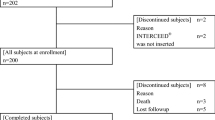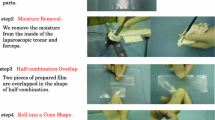Introduction
Although Seprafilm® has been demonstrated to reduce adhesion formation, it is not known whether its usage would translate into a reduction in adhesive small-bowel obstruction.
Methods
This was a prospective, randomized, multicenter, multinational, single-blind, controlled study. This report focuses on those patients who underwent intestinal resection (n = 1,701). Before closure of the abdomen, patients were randomized to receive Seprafilm® or no treatment. Seprafilm® was applied to adhesiogenic tissues throughout the abdomen. The incidence and type of bowel obstruction was compared between the two groups. Time to first adhesive small-bowel obstruction was compared during the course of the study by using survival analysis methods. The mean follow-up time for the occurrence of adhesive small-bowel obstruction was 3.5 years.
Results
There was no difference between the treatment and control group in overall rate of bowel obstruction. The incidence of adhesive small-bowel obstruction requiring reoperation was significantly lower for Seprafilm® patients compared with no-treatment patients: 1.8 vs. 3.4 percent (P < 0.05). This finding represents an absolute reduction in adhesive small-bowel obstruction requiring reoperation of 1.6 percent and a relative reduction of 47 percent. In addition, a stepwise multivariate analysis indicated that the use of Seprafilm® was the only predictive factor for reducing adhesive small-bowel obstruction requiring reoperation. In both groups, 50 percent of first adhesive small-bowel obstruction episodes occurred within 6 months after the initial surgery with nearly 30 percent occurring within the first 30 days. Additionally no first adhesive small-bowel obstruction events were reported in Years 4 and 5 of follow-up.
Conclusions
The overall bowel obstruction rate was unchanged; however, adhesive small-bowel obstruction requiring reoperation was significantly reduced by the use of Seprafilm®, which was the only factor that predicted this outcome.





Similar content being viewed by others
References
MC Parker H Ellis BJ Moran et al. (2001) ArticleTitlePostoperative adhesions: ten-year follow-up of 12,584 patients undergoing lower abdominal surgery Dis Colon Rectum 44 822–830 Occurrence Handle11391142 Occurrence Handle1:STN:280:DC%2BD3Mzkt1Cguw%3D%3D Occurrence Handle10.1007/BF02234701
NF Ray JW Larsen SuffixJr RJ Stillman RJ Jacobs (1993) ArticleTitleEconomic impact of hospitalizations for lower abdominal adhesiolysis in the United States in 1988 Surg Gynecol Obstet 176 271–276 Occurrence Handle8438200 Occurrence Handle1:STN:280:ByyC2svjs10%3D
L Holmdahl B Risberg (1997) ArticleTitleAdhesions: prevention and complications in general surgery Eur J Surg 163 169–174 Occurrence Handle9085057 Occurrence Handle1:STN:280:ByiB3sbjvFE%3D
H Jeekel (1997) ArticleTitleCost implication of adhesions as highlighted ina European study Eur J Surg 579 43–45
J Kossi P Salminen A Rantala et al. (2003) ArticleTitlePopulation-based study of the surgical workload and economic impact of bowel obstruction caused by postoperative adhesions Br J Surg 90 1441–1444 Occurrence Handle14598429 Occurrence Handle1:STN:280:DC%2BD3srhvFSjsg%3D%3D
VW Fazio Y Ziv JM Church et al. (1995) ArticleTitleIleal pouch-anal anastomoses complications and function in 1005 patients Ann Surg 222 120–127 Occurrence Handle7639579 Occurrence Handle1:STN:280:ByqA28notF0%3D
M Niewenhuijzen MM Reijnen JH Kuijper et al. (1998) ArticleTitleSmall-bowel obstruction after total or subtotal colectomy: a 10-year retrospective review Br J Surg 85 1242–1245
H Ellis BJ Moran JN Thompson et al. (1999) ArticleTitleAdhesion-related hospital readmissions after abdominal and pelvic surgery: a retrospective cohort study Lancet 353 1476–1480 Occurrence Handle10232313 Occurrence Handle1:STN:280:DyaK1M3kslaksQ%3D%3D
JM Becker MT Dayton VW Fazio et al. (1996) ArticleTitlePrevention of postoperative abdominal adhesions by a sodium hyaluronate-based adhesion barrier: a prospective, randomized, double-blind multicenter study J Am Coll Surg 183 297–306 Occurrence Handle8843257 Occurrence Handle1:STN:280:ByiD3c%2FhtFA%3D
MP Diamond (1996) ArticleTitleReduction of adhesions after uterine myomectomy by Seprafilm® membrane (HAL-F): a blinded, prospective, randomized, multicenter clinical study. Seprafilm Adhesion Study Group Fertil Steril 66 904–910 Occurrence Handle8941053 Occurrence Handle1:STN:280:ByiD1Mngt10%3D
WW Vrijland LN Tseng HJ Eijkman et al. (2002) ArticleTitleFewer intraperitoneal adhesions with use of hyaluronic acid-carboxymethylcellulose membrane: a randomized clinical trial Ann Surg 235 193–199 Occurrence Handle11807358 Occurrence Handle10.1097/00000658-200202000-00006
DE Beck Z Cohen JW Fleshman HS Kaufman H Goor Particlevan BG Wolff InstitutionalAuthorName, for theAdhesion Study Group Steering Committee (2003) ArticleTitleA prospective, randomized, multicenter, controlled study of the safety of Seprafilm adhesion barrier in abdominopelvic surgery of the intestine Dis Colon Rectum 46 1310–1319 Occurrence Handle14530667 Occurrence Handle10.1007/s10350-004-6739-2
DE Beck FG Opelka HR Bailey SM Rauth CL Pashos (1999) ArticleTitleIncidence of small-bowel obstruction and adhesiolysis after open colorectal and general surgery Dis Colon Rectum 42 241–248 Occurrence Handle10211502 Occurrence Handle1:STN:280:DyaK1M3is1Crtg%3D%3D
RI Zbar WB Crede CF Mclehann JF Jekel (1993) ArticleTitleThe postoperative incidence of small bowel obstruction following standard, open appendectomy and cholecystectomy: a 6 year retrospective cohort study at Yale New Haven Hospital Conn Med 57 123–127 Occurrence Handle8477590 Occurrence Handle1:STN:280:ByyB3sfltVE%3D
D Menzies H Ellis (1990) ArticleTitleIntestinal obstruction from adhesions. How big is the problem? Ann R Coll Surg Engl 72 60–63 Occurrence Handle2301905 Occurrence Handle1:STN:280:By%2BC2cngsVc%3D
M Weibel AG Majno (1973) ArticleTitlePeritoneal adhesions and their relation to abdominal surgery. A postmortem study Am J Surg 126 345–353 Occurrence Handle4580750 Occurrence Handle1:STN:280:CSyB2cjpsFI%3D
I Matter L Khalemsky J Abrahamson E Nash E Sabo S Eldar (1997) ArticleTitleDoes the index operation influence the course and outcome of adhesive intestinal obstruction? Eur J Surg 163 767–772 Occurrence Handle9373228 Occurrence Handle1:STN:280:DyaK1c%2FjvFSltw%3D%3D
H Ellis BJ Moran JN Thompson et al. (1999) ArticleTitleAdhesion-related hospital readmissions after abdominal and pelvic surgery: a retrospective cohort study Lancet 353 1456–1457
NF Ray WG Denton M Thamer SC Henderson S Perry (1998) ArticleTitleAbdominal adhesiolysis: inpatient care and expenditures in the U.S. J Am Coll Surg 186 1–9 Occurrence Handle9449594 Occurrence Handle1:STN:280:DyaK1c7gvFKnug%3D%3D Occurrence Handle10.1016/S1072-7515(97)00127-0
Z Cohen RS McLeod H Stern D Grant S Nordgren (1985) ArticleTitleThe pelvic pouch and ileo-anal anastomosis procedure: surgical technique and initial results Am J Surg 150 601–607 Occurrence Handle4061741 Occurrence Handle1:STN:280:BimD2cfjsVE%3D
SD Wexner WD Wong DA Rothenberger SM Goldberg (1990) ArticleTitleThe ileo-anal reservoir Am J Surg 159 178– 185 Occurrence Handle2153008 Occurrence Handle1:STN:280:By%2BC3c3otVI%3D
W Scovill (1995) Small bowel obstruction JL Cameron (Eds) Current therapy in surgery Mosby Yearbook Medical Publishers St. Louis 100–104
MG Coleman AD McLain BJ Moran (2000) ArticleTitleImpact of previous surgery on time taken for incision and division of adhesions during laparotomy Dis Colon Rectum 43 1297–1299 Occurrence Handle11005501 Occurrence Handle1:STN:280:DC%2BD3cvltVGitQ%3D%3D Occurrence Handle10.1007/BF02237441
AA Krabben Particlevan der FR Dijkstra M Nieuwenhuijzen MM Reijnen M Schaapveld H Goor Particlevan (2000) ArticleTitleMorbidity and mortality of inadvertent enterotomy during adhesiotomy Br J Surg 87 467–471
DE Beck MA Ferguson FG Opelka JW Fleshman P Gervaz SD Wexner (2000) ArticleTitleEffect of previous surgery on abdominal opening time Dis Colon Rectum 43 1749–1753 Occurrence Handle11156462 Occurrence Handle1:STN:280:DC%2BD3M%2FpvFKjsg%3D%3D Occurrence Handle10.1007/BF02236862
MR Salum DT Lam SD Wexner et al. (2001) ArticleTitleDoes limited placement of bioresorbable membrane of modified sodium hyaluronate and carboxymethylcellulose (Seprafilm®) have possible short-term beneficial impact? Dis Colon Rectum 44 706–712 Occurrence Handle11357033 Occurrence Handle1:STN:280:DC%2BD3M3msVehtA%3D%3D Occurrence Handle10.1007/BF02234571
Acknowledgments
The authors thank the many study coordinators and monitors who participated in this study, Beverly Accomando, M.S., the study statistician, and Keith Kelly, M.D., and Jacques Heppell, M.D., Mayo Clinic, Scottsdale, Arizona, who contributed patients to and assisted with the study.
Author information
Authors and Affiliations
Corresponding author
Additional information
Supported by a grant from Genzyme Corporation, which manufacturers Seprafilm.
Read at the meeting of The American Society of Colon and Rectal Surgeons, Dallas, Texas, May 10 to 13, 2004.
Appendix
Appendix
Seprafim® Medical Advisory Steering Committee
David E. Beck, M.D., Zane Cohen, M.D., James W. Fleshman, M.D., Howard S. Kaufman, M.D., Harry van Goor, M.D., Bruce G. Wolff, M.D.
About this article
Cite this article
Fazio, V.W., Cohen, Z., Fleshman, J.W. et al. Reduction in Adhesive Small-Bowel Obstruction by Seprafilm® Adhesion Barrier After Intestinal Resection. Dis Colon Rectum 49, 1–11 (2006). https://doi.org/10.1007/s10350-005-0268-5
Published:
Issue Date:
DOI: https://doi.org/10.1007/s10350-005-0268-5




